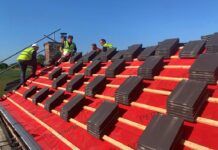 The Department of Energy and Climate Change (DECC) has released data showing that around 7.6m (95%) of homes with solid walls still need to be insulated.
The Department of Energy and Climate Change (DECC) has released data showing that around 7.6m (95%) of homes with solid walls still need to be insulated.
In a series of publications covering the state of insulation in Great Britain’s housing stock, DECC revealed that of 27.3m homes, eight million have solid walls. At the end of September 2014, only 273,000 had solid wall insulation (SWI), which DECC claim is a result of previous Government schemes. A large portion of these homes have only had SWI installed in the 12 months to September 2014, with 56,000 homes having insulation installed in this time.
The remaining properties are said to be predominantly hard to treat homes that are considered to not be cost effective to insulate.
Neil Marshall, chief executive of the National Insulation Association (NIA), said:
“Nearly 8 million homes have solid walls that need insulating, and it is imperative that all political parties make a commitment to – and put in place – robust plans and funding to treat these in a timely manner.”
Conversely, 72% of properties with cavity walls have the insulation required, while 69% of the 23.9m properties with a loft have appropriate insulation, which DECC deems as lofts with at least 125mm of insulation. Only a small number of properties with lofts (around 1%) are estimated to have no insulation at all, however there are still millions of lofts that are thought to have inadequate insulation and need topping up.
DECC says that the key use of these estimates is to identify homes that have the potential to receive cavity wall, loft and SWI in the future. It has already begun to implement initiatives partially designed to address the drastic deficit in homes without SWI. For example, the most recent version of the Green Deal Home Improvement Fund (GDHIF) earmarked œ24m of the œ30m released for SWI only. However, this is unlikely to fill the gap left by government cuts to the ECO scheme.
Mr. Marshall added: “Under the original Energy Company Obligation there were expected to be around 60,000 SWI installations a year between 2013 and 2017, however as a result of the cuts made to the ECO by Government in July 2014, this has now fallen to around 25,000. Whilst the GDHIF is helpful it is only a three year programme and even if the entire œ150m per year was spent on SWI, it would only result in around 30,000 installations. At a combined rate of 55,000 installs per year it would take around 140 years to insulate all the solid walls.
“What is needed is a long-term plan supported by appropriate levels of funding to insulate the entire housing stock. We are therefore calling on all political parties to define energy efficiency retrofit of the UK housing stock a national infrastructure priority, and to make additional funds available from the Government’s national infrastructure budget to get the job done.”
There has also been criticism of the structure of the GDHIF, particularly as the SWI funding included in the latest incarnation of the fund was allocated in just over a day. As reported by Roofzine in December 2014, the strategy was criticised for being a ?feast and famine’ approach that will not address the issue with enough speed.




